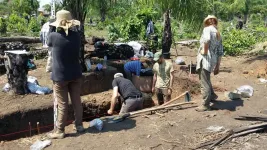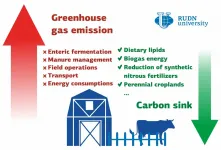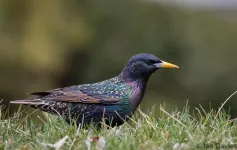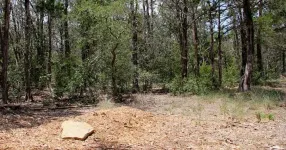INFORMATION:
Ancient Amazonian farmers fortified valuable land they had spent years making fertile to protect it
2021-02-09
(Press-News.org) Ancient Amazonian communities fortified valuable land they had spent years making fertile to protect it from conflict, excavations show.
Farmers in Bolivia constructed wooden defences around previously nutrient-poor tropical soils they had enriched over generations to keep them safe during times of social unrest.
These long-term soil management strategies allowed Amazonians to grow nutrient demanding crops, such as maize and manioc and fruiting trees, and this was key to community subsistence. These Amazonian Dark Earths, or Terra Preta, were created through burning, mulching, and the deposition of organic waste.
It was known that some communities built ditches and embankments, known locally as a zanja, around their settlements, which had suggested to act as a defensive structure. The examples from Bolivia were specifically constructed to also enclose the enriched soil and this is the first evidence of an additional fortification built in the ditch, demonstrating how important communities felt it was to protect their investment in the land.
Excavations, at the Versalles archaeological site along the Iténez River in the Bolivian Amazon, provide the first archaeological evidence that communities in the region built wooden palisades along with earthworks. The construction circles the outer perimeter of the village, enclosing and protecting homes and the enriched soil and forest.
Researchers had long speculated on the function of the zanjas and whether there had also been a palisade structure, but until now no direct evidence of a wooden construction had been found. The harsh tropical climate is unfavourable for the preservation of wooden architecture, but through careful excavation, the decomposed remains of the construction posts were detected in the soil. It is not possible to know what the structure would have looked like.
Archaeological analysis show that those living in Versalles began enriching soils around 500 BC. After almost two millennia, the zanja was constructed around AD 1300, at the same time as social unrest spread across Amazonia. The fortifications were later remodelled, including the addition of the palisade, around AD 1628 to 1803. Archaeological excavations suggests the community continued to thrive during this time, creating elaborate ceramics and producing a diversity of foods from staple crops to fruits and nuts, alongside fish and hunted animals.
The research, published in the journal Geoarchaeology, was conducted in collaboration with the modern Versalles community, by Dr.Mark Robinson and Professor. Jose Iriarte from the University of Exeter, Dr. Carla Jaimes?Betancourt, from the University of Bonn, Dr. Sarah Elliott, from Bournemouth University, and Dr. Yoshi Maezumi, from the University of Amsterdam, with students from the UK and Bolivia participating in excavations.
Dr Robinson said: "This is further evidence the Amazon is not a pristine place, untouched by human hands. People have had a great impact on the ecology of the rainforest. Communities invested heavily, generation after generation, to enrich the natural resources around them. As broad Amazon-wide social-unrest spread, the community felt the need to protect the resources into which they and their ancestors had invested so much."
ELSE PRESS RELEASES FROM THIS DATE:
RUDN University ecologist suggested a way to reduce greenhouse gas emissions in animal farming
2021-02-09
An ecologist from RUDN University suggested a method to evaluate and reduce the effect of animal farms on climate change and developed a set of measures for small farms that provides for the complete elimination of greenhouse gas emissions. The results of the study were published in the Journal of Cleaner Production.
Crop and animal farming and other agricultural activities account for almost a quarter of all greenhouse gases produced by humanity and therefore add a lot to climate change. On the other hand, the soils and biomass accumulate a lot of carbon, thus preventing it from getting into the atmosphere as a part of carbon dioxide and slowing climate change down. An ecologist from RUDN University suggested ...
Starling success traced to rapid adaptation
2021-02-09
Ithaca, NY--Love them or hate them, there's no doubt the European Starling is a wildly successful bird. A new study from the Cornell Lab of Ornithology examines this non-native species from the inside out. What exactly happened at the genetic level as the starling population exploded from just 80 birds released in New York City's Central Park in 1890, peaking at an estimated 200 million breeding adults spread all across North America? The study appears in the journal Molecular Ecology.
"The amazing thing about the evolutionary changes among starling populations ...
Lipid composition of microalgae of the Kaliningrad Region was determined
2021-02-09
The term "algae" is used to refer to over 72,500 identified aquatic species. The size of algae is up to tens of meters, however, most (about 80%) of the species are much smaller - they comprise the microalgae group. Microalgae are rich in nutrients and biologically active substances such as proteins, carbohydrates, lipids, vitamins, pigments and others. These components are widely used in food, cosmetic, chemical and energy industries. Biotechnology of microalgae has multiple advantages: they are a renewable and sustainable resource, more productive than terrestrial plants due to their high growth rate and lack of seasonality ...
Researchers study how lifelong environmentalists want their remains handled after death
2021-02-09
LAWRENCE -- Traditional burial in a graveyard has environmental costs. Graves can take up valuable land, leak embalming chemicals and involve nonbiodegradable materials like concrete, as well as the plastic and steel that make up many caskets. But the other mainstream option -- cremation -- releases dangerous chemicals and greenhouse gasses into the environment.
So, what's an environmentalist to do when making plans for the end of life?
A new study from the University of Kansas in the journal Mortality details how older environmentalists consider death care and how likely they are to choose "green" burials and other eco-friendly options.
"This article is specifically asking if older adult environmentalists consider how their bodies are going to ...
Human eye beats machine in archaeological color identification test
2021-02-09
GAINESVILLE, Fla. --- A ruler and scale can tell archaeologists the size and weight of a fragment of pottery - but identifying its precise color can depend on individual perception. So, when a handheld color-matching gadget came on the market, scientists hoped it offered a consistent way of determining color, free of human bias.
But a new study by archaeologists at the Florida Museum of Natural History found that the tool, known as the X-Rite Capsure, often misread colors readily distinguished by the human eye.
When tested against a book of color chips, the machine failed to produce correct color scores in 37.5% of cases, even though its software system included the same set of chips. In an analysis of fired ...
Collective worm and robot 'blobs' protect individuals, swarm together
2021-02-09
Individually, California blackworms live an unremarkable life eating microorganisms in ponds and serving as tropical fish food for aquarium enthusiasts. But together, tens, hundreds, or thousands of the centimeter-long creatures can collaborate to form a "worm blob," a shape-shifting living liquid that collectively protects its members from drying out and helps them escape threats such as excessive heat.
While other organisms form collective flocks, schools, or swarms for such purposes as mating, predation, and protection, the Lumbriculus variegatus worms are unusual in their ability to braid themselves together to accomplish tasks that unconnected individuals cannot. A new study reported by researchers at ...
New CRISPR tech targets human genome's complex code
2021-02-09
HOUSTON - (Feb. 9, 2021) - Finding a needle in a haystack is hard enough. But try finding a specific molecule on the needle.
Rice University researchers have achieved something of the sort with a new genome editing tool that targets the supporting players in a cell's nucleus that package DNA and aid gene expression. Their work opens the door to new therapies for cancer and other diseases.
Rice bioengineer Isaac Hilton, postdoctoral researcher and lead author Jing Li and their colleagues programmed a modified CRISPR/Cas9 complex to target specific histones, ubiquitous epigenetic proteins that keep DNA in order, ...
Astronomers offer possible explanation for elusive dark-matter-free galaxies
2021-02-09
RIVERSIDE, Calif. -- A team led by astronomers at the University of California, Riverside, has found that some dwarf galaxies may today appear to be dark-matter free even though they formed as galaxies dominated by dark matter in the past.
Galaxies that appear to have little to no dark matter -- nonluminous material thought to constitute 85% of matter in the universe -- complicate astronomers' understanding of the universe's dark matter content. Such galaxies, which have recently been found in observations, challenge a cosmological model used by astronomers called Lambda Cold Dark Matter, or LCDM, where all galaxies are surrounded by a massive and extended dark matter halo.
Dark-matter-free galaxies are not well understood in the astronomical community. ...
Combination therapy with radiation shows promise in treating glioblastoma
2021-02-09
UCLA RESEARCH ALERT
FINDINGS
In a study of mice, researchers at the UCLA Jonsson Comprehensive Cancer Center have identified a new approach that combines an anti-psychotic drug, a statin used to lower high cholesterol levels, and radiation to improve the overall survival in mice with glioblastoma. Glioblastoma is one of the deadliest and most difficult-to-treat brain tumors. Researchers found the triple combination extended the median survival 4-fold compared to radiation alone.
BACKGROUND
Radiation therapy is part of the standard-of-care treatment regimen for glioblastoma, often helping prolong the survival of patients. However, survival times have not improved significantly over the past two decades and attempts to improve the efficacy ...
Long-term environmental damage from transportation projects in Kenya, scientists warn
2021-02-09
The construction of a major railway through Kenya will have long-term environmental impacts on the area, suggesting more work needs to be done to limit the damage on future infrastructure projects, a major study reveals.
The biggest impact of the Standard Gauge Railway (SGR), which runs from Mombasa to Nairobi, was pollution and contamination of soil, water and air, as well as disruption of natural processes.
The research, led by the University of York and part of the Development Corridors Partnership project, also showed environmental issues as a result of breaking up large areas of habitat into smaller, more isolated patches, that may not be able to support long-term natural processes.
The SGR project was given the go-ahead following the completion ...







